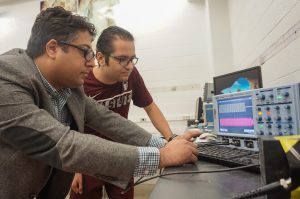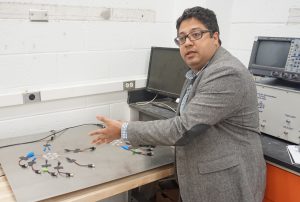By: Linda Fresques
 |
|
| Ehsan Dehghan-Niri and Ph.D. student Sina Zamen examine structural monitoring instrumentation in the Intelligent Structures and Nondestructive Evaluation Laboratory at New Mexico State University. |
It was a national tragedy that inspired New Mexico State University Civil Engineering Assistant Professor Ehsan Dehghan-Niri to pursue a quest to make the world a safer place by means of his field of study in advanced nondestructive evaluation (NDE/NDT) and structural health monitoring (SHM). While he was an undergraduate student in 2003, a 6.6 magnitude earthquake struck the city of Bam in his home country of Iran, killing more than 26,000 people and injuring just as many.
“As a student in civil engineering, I felt I had to go to see the destruction. I went and the devastation was shocking. I felt I had to do something and decided that I would pursue my master’s degree in vibration control systems,” said Dehghan-Niri. He continued on to earn a Ph.D. in structural engineering at the University of Buffalo.
Dehghan-Niri, who joined NMSU in Jan. 2017, is continuing on that path, leading the Intelligent Structures and Nondestructive Evaluation (ISNDE) Laboratory.
Aging infrastructure – bridges, aircraft, pipelines, etc. – is a worldwide problem, not just in the U.S., that affects the health and safety of all people.
D+ was the grade earned by America’s infrastructure in the 2017 American Society of Civil Engineers’ report card which evaluates the condition and performance of the nation’s infrastructure based on the physical condition and needed investments for improvement. Some examples:
- The U.S. has 614,387 bridges, almost four in 10 of which are 50 years or older. 56,007 — 9.1 percent — of the nation’s bridges were structurally deficient in 2016.
- Drinking water is delivered via one million miles of pipes across the country. Many of those pipes were laid in the early to mid-20th century with a lifespan of 75 to 100 years.
 |
| Ehsan Dehghan-Niri shows an array of array of ultrasound sensors used to detect a crack in an aluminum plate. |
“As scientists, we need to be able to monitor the health of and evaluate the level of reliability of structures that we all rely on,” said Dehghan-Niri.
His research is focused on developing novel approaches and methods to monitor structure health using sensing systems which gather and communicate sound and visual information to computers, in real time, detecting cracks, corrosion and critical stresses and other deficiencies. The new generation of smart structures can be designed to include these systems.
Older structures that are not equipped with structural monitoring equipment require an approach that will not interrupt their use. Advanced nondestructive testing methods such as ultrasound, X-ray, magnetic particle and visual testing should be developed to inspect or evaluate materials, components or assemblies for discontinuities, or differences in characteristics without destroying the serviceability of the part or system..
Dehghan-Niri likens the approach to the way medical doctors monitor the health of their patients, diagnosing the problem, developing a prognosis and a treatment plan.
The challenge is to develop SHM methods to: 1. damage localize, 2. damage diagnose and most importantly, 3. damage prognosis. . This information is important to decision making: determining the severity of the problem, assessing the risks and life span of the structure, and developing a repair plan.
“This is super difficult to do, but critical to safety and avoiding dangerous situations. It is critical to determine the level of risk that may have a devastating effect on people and the environment,” said Dehghan-Niri.
Some of the research performed in the ISNDE Laboratory involve additive manufacturing. Dehghan-Niri is developing an algorithm for 3D printing using fiber-reinforced concrete for advanced structures. He is developing a smart nozzle that may revolutionize the properties of concrete. This is in process for patenting. Another project is investigating the adhesion of polymer layers, being conducted in partnership with Oak Ridge National Laboratory. He is also working with Arizona State University on robotic devices to be used in underground, pipeline and power plant inspections. A NASA EPSCORE grant supports research using mini cameras with long-range strain measurement.
During his short time at NMSU, Dehghan-Niri has equipped an unused 200 square-foot laboratory with myriad state-of-the-art ultrasonic testing, acoustic emission and vision-based instrumentation where he and his students, two Ph.D. candidates and two undergraduates, conduct their studies.
Included is a prized immersion tank used for ultrasound imaging. The tank belonged to Dr. Robert Green, co-founder of Johns Hopkins University’s Department of Materials Science who passed away this past November. Dehghan-Niri describes Green as his academic grand-grandfather – his adviser’s adviser’s adviser.
“This is how knowledge gets passed on and built upon,” he said. “I worked at General Electric and when I finished something, that was it—it was done. I wanted to go into academia to keep the knowledge going. Now I share it with my students.”
# # #
CUTLINE: Ehsan Dehghan-Niri and Ph.D. student Sina Zamen examine structural monitoring instrumentation in the Intelligent Structures, Nondestructive Evaluation Laboratory at New Mexico State University.
CUTLINE: Ehsan Dehghan-Niri shows an array of array of ultrasound sensors used to detect a crack in an aluminum plate.
